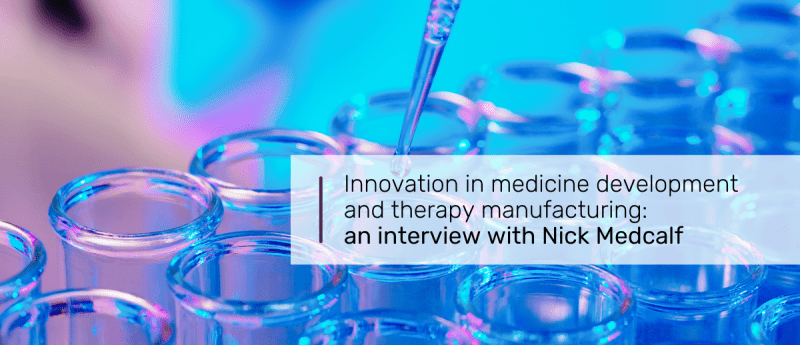Innovation in medicine development and therapy manufacturing: an interview with Nick Medcalf

 In this interview with Nick Medcalf of Innovate UK (Swindon, UK), we explore recent developments in the spheres of medicine development and therapy manufacturing after catching up at the Advanced Therapies Europe conference (31 August–1 September 2022, London, UK). Nick discusses which areas of manufacturing have the most potential, how collaboration can make this happen and what challenges he predicts may lie in the way, so be sure to read the insightful discussion below.
In this interview with Nick Medcalf of Innovate UK (Swindon, UK), we explore recent developments in the spheres of medicine development and therapy manufacturing after catching up at the Advanced Therapies Europe conference (31 August–1 September 2022, London, UK). Nick discusses which areas of manufacturing have the most potential, how collaboration can make this happen and what challenges he predicts may lie in the way, so be sure to read the insightful discussion below.
Please could you introduce yourself and your company?
My name is Nick Medcalf and I work for Innovate UK. I’m one of two Deputy Challenge Directors for what used to be known as the Medicines Manufacturing Programme back in the days of the UK government’s Industrial Strategy Challenge Fund. This was completed last year and is now morphing into something called Transforming Medicines Manufacturing to reflect the new funding that has come through with a settlement last year for the new funding phase. Our role is to ensure that the UK’s health and wealth are served by promoting and supporting new businesses and innovations in the health sector. As the name suggests, this is principally in the sphere of medicine development but also concerns developing new tools to facilitate medicine administration and supply.
What area of manufacturing do you think has the biggest opportunity for optimization?
We’re going through a period at the moment where it is absolutely essential to make sure that new medicines and, to an extent, older medicines that are utilized for new routes of administration, are available to the patient within a context that makes economic sense. Additionally, it is vital that we meet the global targets for net zero.
Historically, this has been a sector with quite a lot of revenue generation and this has meant that there hasn’t been much pressure to think about ways of reducing raw material consumption. Now, we want to make sure that, as far as possible, nothing is wasted. In many cases, this may mean that we’re producing to order rather than to stock.
When you think about net zero and energy utilization, it’s easy to focus on efficiency measures. However, with medicines manufacturing, there’s a fundamental level before that: if you’re not going to utilize a particular medicine, don’t make it. So, we’re now looking at things like the way the supply chain works, how procurement works with the clinics and the way in which there might be win–win situations for the manufacturers and the customers.
Regarding decentralized manufacturing, there are some areas of non-advanced therapies where it might be useful. For example, as we’re very agile now after COVID-19 in making things like mRNA-based vaccines, which don’t require very much active material for each dose to produce huge batches, it might be prudent to think about ways in which a new vaccine could reach the population more quickly if it was made on-demand through decentralized processes. For example, if there were compact centers where the active material is made and then shipped to regional centers for fill finish and immediate application to inoculation campaigns for the public.
Could these manufacturing techniques apply to cell and gene therapy, or would this be much more therapy specific?
When you’re dealing with life-threatening diseases, like leukemia for example, the high value associated with the therapy means that there’s a lot more maneuverability for the commercial design of the supply process. However, there are situations where a non-life-threatening condition could in principle be treated by a cell- or gene-based therapeutic and this is typically done in campaigns.
A good example would be the treatment of arthritis of major joints; at the moment, if you have an injection with a steroid to suppress inflammation for a knee problem, the drug administration is typically done in campaigns by an orthopedic specialist during a Friday morning clinic, for example, where clinicians may line up 12 or 15 patients and do them in quick succession. Essentially, because the condition is not life-threatening, clinicians can take their time. By the same token, if you’re applying, for example, cell therapy to remediate cartilage loss in a joint, you can imagine that the cell therapy might be prepared in a moderately sized batch for immediate utilization with say, 20 patients on a particular day at a particular clinic.
What challenges do you foresee when it comes to moving forward with manufacturing?
I think that this is a very big topic. I think a good analogy of the current focus on decentralized manufacturing is what happened with video production, where VHS got there first, even though some would argue that Betamax was a better product. This happened because VHS was commercialized more quickly and with more aggressive marketing, so people who wanted to utilize the platform were structuring their business around its availability.
This is relevant to us now because if we start creating novel ways of manufacturing more efficient, cost-effective and personalized therapies, once somebody can engineer successful models of operation and create a delivery process that really works, they have essentially established a new paradigm for that operation. What you tend to find with this is that inventors will start thinking very early on about the fact that they can take that particular route – in other words, think about what kind of therapies would fit this manufacturing technique, rather than thinking about what manufacturing technique would best suit a particular disease’s therapy.
The benefit of this is that drugs can reach clinics very quickly, however there is the challenge of how to make sure that the integrated service, which involves several different players, actually works. This is going to require a much better understanding of human factors. Additionally, it will require business research specialists because I believe we’ll see the emergence of more ‘collaborative enterprises’, where people can save costs by not bringing all the elements of the supply chain into their companies through sharing resources with partner operations and also outsourcing where necessary.
In the microelectronics industry, precedent was set for this a couple of decades ago – when individual companies found it far too expensive to have all their own quality assurance, personnel and material transportation processes – so they started looking around and seeing who they could work with. To do that, you create new business enterprises, where the different companies are part of an overarching management structure so that each can pursue their own business but they can also work together and gain support.
How much of a role does collaboration play when developing a new therapy?
I think it’s vital and there’s a huge need for skills and training development. What we need is more people from training centers and from apprenticeship schemes who have been exposed to the complementary skill sets of people that they would have to work with in a fully operational business. For example, somebody who may be an engineer with a passion for designing bioreactors would need to understand enough about regulatory standards, metrology, quality assurance, quality control and beyond, to know when there are opportunities for enhancing their products to make life easier and integrate better with their colleagues later on. Plus, this is important to avoid the pitfall of painting themselves into a corner and having to re-engineer something already in the market just because some aspect of manufacture has changed (for example, when a specialized piece of equipment is no longer supported by the manufacturer).
Do you have any broad predictions for the future of the field?
I think we’re going to see the emergence of a new category of specialists who are often referred to as ‘system engineers’. Systems engineering has become vital to integrate the different players in the supply chain, but also to make sure that certain situations are avoided.
When you mention the idea of systems engineering and manufacturing to people, they normally just think about integrating digital systems. For example, they ask: how do we get computers to talk to each other? How do we get automated equipment to talk to each other? This is part of the picture but I’m talking more broadly. I’m talking about people that have got a specialist knowledge base who can come in, look at the situation with a novel product, look at the available technological platforms and discuss what the possible options are. They can discuss which options offer what benefits, how each option would integrate best with the type of clinicians or GP practice or whatever is being looked at.
Do you think AI could come into play here?
I think AI can be applied to a lot but I think human insights are really important. As an example, while I was still working in industry, we used to have the occasional project, which we would refer to as an ‘insights project’. What we would do is send a small group of staff to work alongside the customers, who would typically be surgeons or individuals in a clinical setting who were administering a drug or medical device. The purpose of these insights projects was to collect information, photographs and recordings – just observational procedures – but, most importantly, to ask questions. It was often really useful to choose relatively early career people who wouldn’t go in with any preconceptions about how things should be done because quite often you can find that something has become the ‘done thing’ only because of history but not because it’s what makes sense now. I think that’s the kind of opportunity that I think we’re going to see more of and it will probably invoke a paradigm shift.
You might also like:
- Sustainability in pharma: an interview with Joel Eichmann
- From decentralized manufacturing to allogeneic therapy: an interview with Greg Roumeliotis, VP Global Business Development, Orgenesis, Inc.
- Novel modular 3D printed microfluidic system for continuous stem cell harvesting and manufacturing
Disclaimer
The opinions expressed in this interview are those of the interviewee and do not necessarily reflect the views of RegMedNet or Future Science Group.





